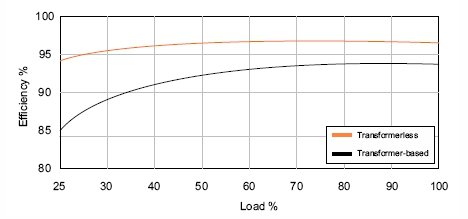News
Keeping Your UPS Green and Efficient
As uninterruptible power supplies (UPS) systems became popular and then indispensable for data centres, users’ expectations were simply focused; they wanted guaranteed and clean power. Today’s business climate is changing this, as it exerts pressure on data centre operators to control rising energy costs and preserve their Green credibility.
In this article, Alan Luscombe, director at Uninterruptible Power Supplies Ltd, a Kohler Company, looks at how developments in UPS technology can help users optimize their energy efficiency while balancing power protection and energy efficiency.
When UPS systems first became commercially available in the 50s, they appeared as rotary or ‘no break’ systems comprising a rectifier, charger, battery, DC motor and AC generator. As the power train relied on the mechanical link between the motor and generator, isolation from mains-borne events such as spikes was excellent, but efficiency was relatively low at typically 84 – 88%. However in those days, energy was relatively cheap and Green strategies were not yet a political or social consideration.
By comparison, today’s users’ expectations of their UPS have become far more stringent. As many organisations depend on online, real-time transactions and communications to remain in existence, the availability of clean, uninterrupted power is business-critical rather than merely highly desirable. Additionally, the pressure felt by UPS vendors to assure this availability is now matched by the pressure to do so efficiently, for both financial and Green reasons.
Financially, any shortfall in UPS efficiency gives rise to costs, both directly through energy losses and indirectly as these losses create a cooling requirement. This adds up to a significant financial burden as energy prices continue to rise, yet other efficiency-related pressures exist as well. If organisations fail to implement an effective Green policy they can fall foul of increasing legislation, and their public reputation can be damaged.
Fortunately, improvements in UPS technology mean that with the right UPS topology and configuration, users today can achieve up to 99% efficiency from their UPS installation. One of the first great advances arose from the development of static, semiconductor inverter-based systems to replace the rotary types. These brought an improvement in efficiency, which however was limited because these systems required a transformer to match the inverter output to the 240 Vac needed by the critical load. This introduced inefficiency as well as adding physical size and weight to the UPS equipment.
However, further advances in semiconductor technology and the introduction of the Insulated Gate Bipolar Transistor (IGBT) have led to UPS designs that eliminate the transformer entirely. Fig. 1 shows the effect this has had on improving UPS efficiency. The graph shows an efficiency gain of around 5%, yielding a substantial reduction in energy running costs and heat loss. The transformerless design also features an input power factor which is less load-dependant and much closer to unity than that of a transformer-based design. Improving a UPS’s input power factor towards unity reduces the magnitude of the input currents, so reducing the size of the associated cabling and switchgear. Electricity running costs can sometimes also be reduced.
Fig 1: Transformerless and transformer-based UPS efficiency/load curves
The reduction in size and weight achieved by eliminating the transformer is also important. For example a 120 kVA transformerless design weighs less than a third of its transformer-based equivalent, and occupies just over a third of its footprint. These physical reductions have allowed a fundamental new approach to UPS topology, in which flexible UPS systems of all sizes are configured using rack-mounting modules. Ranging in capacity from 10 kVA to 50 kVA, these modules can be incrementally added to the UPS rack, so that the UPS remains ‘right-sized’ to a facility’s changing load. This flexibility maximises efficiency by keeping the UPS fully loaded, while also easing redundancy, availability and scalability.
These factors – transformerless design and modular topology – allow UPS users to achieve up to 96% efficiency. However, a data centre can now achieve further UPS efficiencies, right up to 99%, if its circumstances allow eco-mode operation. In eco-mode the UPS operates off-line during normal utility power availability, with the static switch conducting incoming mains directly through to the critical load. The switch brings the UPS online if a mains fault is detected. The tradeoff for eco-mode’s efficiency is that the load is exposed to any mains disturbances and frequency variations, as well as to complete power failure.
In practice, though, the capabilities of the ICT equipment that typically comprises today’s critical load, together with the power quality available from mature utility networks mean that these external disturbances can be handled safely in many installations. Modern ICT equipment is typically expected to ride through power breaks of up to 20 mS, and UPSs can come on line well within this time. Similarly, ICT equipment’s tolerance of mains frequency variations can exceed those experienced from a good utility. Transient voltage surge suppressor devices can protect against high energy voltage spikes.
As energy costs and Green pressures continue to rise, data centres will continue their drive to improve efficiency. Their choice of UPS will contribute to this if they choose systems with modern transformerless technology and modular topology that allows ongoing rightsizing of UPS to load, and operate these systems in Eco mode whenever it is safe to do so.


